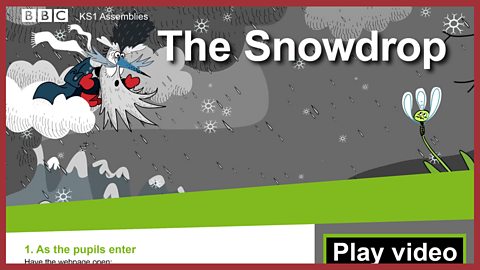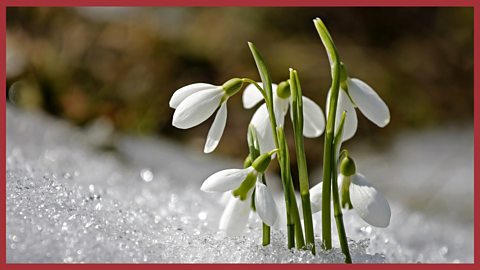In short...
Themes: New beginnings; seasons; signs of spring; hope; courage; change; being true to yourself; New Year's resolutions
Summary: Snowdrops are small plants, typically 15 cm tall. They have three large outer petals and three smaller inner ones. The hardened leaf-tips of its three narrow leaves help the snowdrop break through frosty ground. The snowdrop is sometimes called 'flower of hope' because it comes so early in the year.
Resources: an surrounded by snow.

The video
It is New Year and snow lies upon the ground. Under the earth the Snowdrop is snug and warm inside her bulb. A ray of winter sunshine reaches her and she grows towards the light and breaks through to the world. But the North Wind tells the Snowdrop she has come out too soon - she can't possibly survive the night. The Snowdrop battles the winter weather through the nightβ¦and in the morning she is proud to be recognised as the very first flower of the New Year, a welcome reminder that winter will soon be over.
Duration: 4' 32"
Final words: 'β¦proud to be the first; the first sign of spring.'
Video questions
- Where is the Snowdrop at the start of the story? (In her bulb under the ground.)
- When she was still in her bulb, what did the Snowdrop say she wanted to do? (To stretch and reach towards the air. She says: 'I want to stretch. I want to reach up into the world. I want to open up my petals and feel the fresh air.')
- Who does the Snowdrop meet in the world? (The Sun, The North Wind, a little girl and her mother.)
- How many big white petals does the Snowdrop have? (Three.)
- Why does the Snowdrop think it is time to grow? (She feels the warmth of a sunbeam.)

Key links
Download / print the assembly framework ready for use

Click to display the image full-size


Suggested framework
1. Entry music If you include either of the songs 'We will grow' or 'All things bright and beautiful' you could play the backing tracks as entry music - see 'Related links'.
2. Introduction Display the image of snowdrops. Ask the children: 'Have you seen flowers like this before? Where? Does anyone know what they are called?' [Establish that these are snowdrops and they come out very early in the New Year - a sign that spring is coming.] Ask the children to count the petals of the flowers shown in the image. Ask, 'What words would you use to describe the flowers? Do you know the names of any other flowers that come in spring?' [Guide the children towards descriptions and names of daffodils, hyacinths, crocuses, bluebells and primroses.] Ask the children to watch out for these flowers in the days to come. Remind the children: 'It is not spring yet, it's still winter. But once we see the first snowdrops, it's a sign spring is on the way. Here's a story about the very first snowdrop of allβ¦' Now play the video.
3. The video Play the video. The duration is 4' 32" and the final words are: 'β¦the first sign of spring.'
4. After the video You could use the Story questions to help the children focus on details from the video clip.
5. Time to talk Ask: 'Why do you think the Snowdrop wanted to reach up into the world? How do you think the Snowdrop felt when she was in her bulb under the ground? How do you think she felt when she was growing? How do you think she felt when the storm came? How do you think she felt the next day?' The children could act out the Snowdrop's journey in life. If there is enough space they could curl up tight and then gradually grow up, bursting through the earth. They could be rocked by the storm and finally open their petals to the sun of the new day. [If space is limited, ask the children to use just one hand to act out the Snowdrop's journey.] Now ask: 'What can we learn from the Snowdrop's story? What is her message to all of us?' [Again, gather the children's responses, which might include: 'The snowdrop is brave' or 'She doesn't let the North Wind scare or bully her' or 'She stands up for herself' or 'She is true to herself'. Looking ahead to the New Year, ask the children: 'What good things do you want to do with your life?' Tell them: 'At this time of year people make resolutions, promises to themselves about the good things they want to do. Like the Snowdrop, decide in your head on one good thing that you would like to do this year.'
6. Opportunity to sing If your assembly is to include a song this would be a good time for it. Suggestions from ΒιΆΉΤΌΕΔ collections below.
7. Opportunity for reflection 'The snowdrop is a sign of hope and new beginnings and a promise of good things to come. Think to yourself about the good things we can all do in this hopeful New Year. Think how you can be like a snowdrop in your heartβ¦and mind.'
8. Opportunity for prayer Use your standard form of address ('Dear God', 'Lord Jesus', etc) and: βWe thank you for the snowdrop, a sign of hope and new beginnings and a promise of good things to come. Help us, too, to be snowdrops in our hearts and minds. Help us to be signs of hope and good things in the bright New Year ahead. Amen.β

Suggested songs
All things bright and beautiful (vocal)
All things bright and beautiful,
All creatures great and small,
All things wise and wonderful,
The Lord God made them all.
- Each little flowβr that opens,
Each little bird that sings,
He made their glowing colours,
He made their tiny wings:
Chorus
- The purple-headed mountain,
The river running by,
The sunset and the morning,
That brightens up the sky:
Chorus
- The cold wind in the winter,
The pleasant summer sun,
The ripe fruits in the garden,
He made them everyone:
Chorus
- He gave us eyes to see them,
And lips that we might tell
How great is God Almighty
Who has made all things well:
Chorus
All things bright and beautiful - backing track
All things bright and beautiful,
All creatures great and small,
All things wise and wonderful,
The Lord God made them all.
- Each little flowβr that opens,
Each little bird that sings,
He made their glowing colours,
He made their tiny wings:
Chorus
- The purple-headed mountain,
The river running by,
The sunset and the morning,
That brightens up the sky:
Chorus
- The cold wind in the winter,
The pleasant summer sun,
The ripe fruits in the garden,
He made them everyone:
Chorus
- He gave us eyes to see them,
And lips that we might tell
How great is God Almighty
Who has made all things well:
Chorus
Back in school again - Vocal
Weβre here starting the year,
Everybody back from their holiday.
New term, plenty to learn,
Everyone together again.
Back in school again,
Meeting all our friends,
Here with all of our teachers,
Every one of us
Makes a difference,
Letβs do the best that we can!
Weβre all part of the school,
Everyone is very important, so
Whoβs new? How do you do?
Weβre so glad youβre joining us too.
Back in school again,
Meeting all our friends,
Here with all of our teachers,
Every one of us
Makes a difference
Letβs do the best that we can!
Weβre here starting the year,
Everybody back from their holiday.
New term, plenty to learn,
Everyone together again.
Back in school again - Backing
Weβre here starting the year,
Everybody back from their holiday.
New term, plenty to learn,
Everyone together again.
Back in school again,
Meeting all our friends,
Here with all of our teachers,
Every one of us
Makes a difference,
Letβs do the best that we can!
Weβre all part of the school,
Everyone is very important, so
Whoβs new? How do you do?
Weβre so glad youβre joining us too.
Back in school again,
Meeting all our friends,
Here with all of our teachers,
Every one of us
Makes a difference
Letβs do the best that we can!
Weβre here starting the year,
Everybody back from their holiday.
New term, plenty to learn,
Everyone together again.

